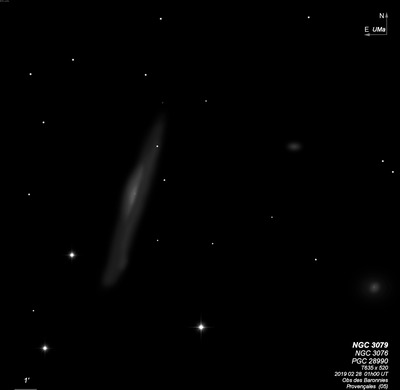
William Herschel discovered NGC 3079 = H V-47, along with NGC 3073, on 1 Apr 1790 (sweep 955) and recorded "cB or vB, mE from np to sf, about 8' l and 2' br, vgmbM." His position is accurate.
400/500mm - 17.5" (3/12/88): very bright, large, edge-on 6:1 NNW-SSE, bright core. Forms a trio with NGC 3073 10' WSW and MCG +09-17-009 6' NW (noted as "very faint, very small, round.") To the south is a triangle of bright stars; mag 9.0 SAO 27486 7' SE, mag 8.3 SAO 27476 6' SSW and mag 9.1 SAO 27482 3.3' SE of center.
900/1200mm - 48" (4/18/15): I made another short observation of this remarkable asymmetric edge-on at 375x and 488x before observing the Twin Quasars, which lie 14' NNW. The brightest portions of this 6:1 edge-on NNW-SSE is warped and bowed out towards the east in the very bright central section. An intense nucleus is within this central section, though offset to the east of center. The west side of the central section is irregular in surface brightness due to dust. The northern extention thins and has a slight bend on the north end, beyond a mag 14 star. On the south side is a bright streak, but to the east of this streak and further south the galaxy is dusty and sections of the galaxy appear to be highly obscured. Two mag 14 stars are off the west side of the galaxy and mag 9.6 HD 237858 is 3.5' SE of center.
Both components of the Twin Quasars at mag 16.7 and 16.9 were easily visible nearly continuously at 697x. The southern component was clearly slightly brighter, although the delta mag is only 0.2. At 6" separation, the pair was relatively widely split.
48" (4/6/13): I only took a quick look at this gorgeous showpiece edge-on at 375x. The entire length of the galaxy appeared very mottled, clumpy and dusty, although there was no distinct dust lane. The shape is irregular and sharply rises to an intense, very elongated 4:1 core that bulges and appears offset from the geometric center. A mag 14 star is superimposed on the north side and SDSS J100200.73+554247.0, an extremely faint galaxy (V = 18.6), was glimpsed 1.2' E.
Notes by Steve Gottlieb